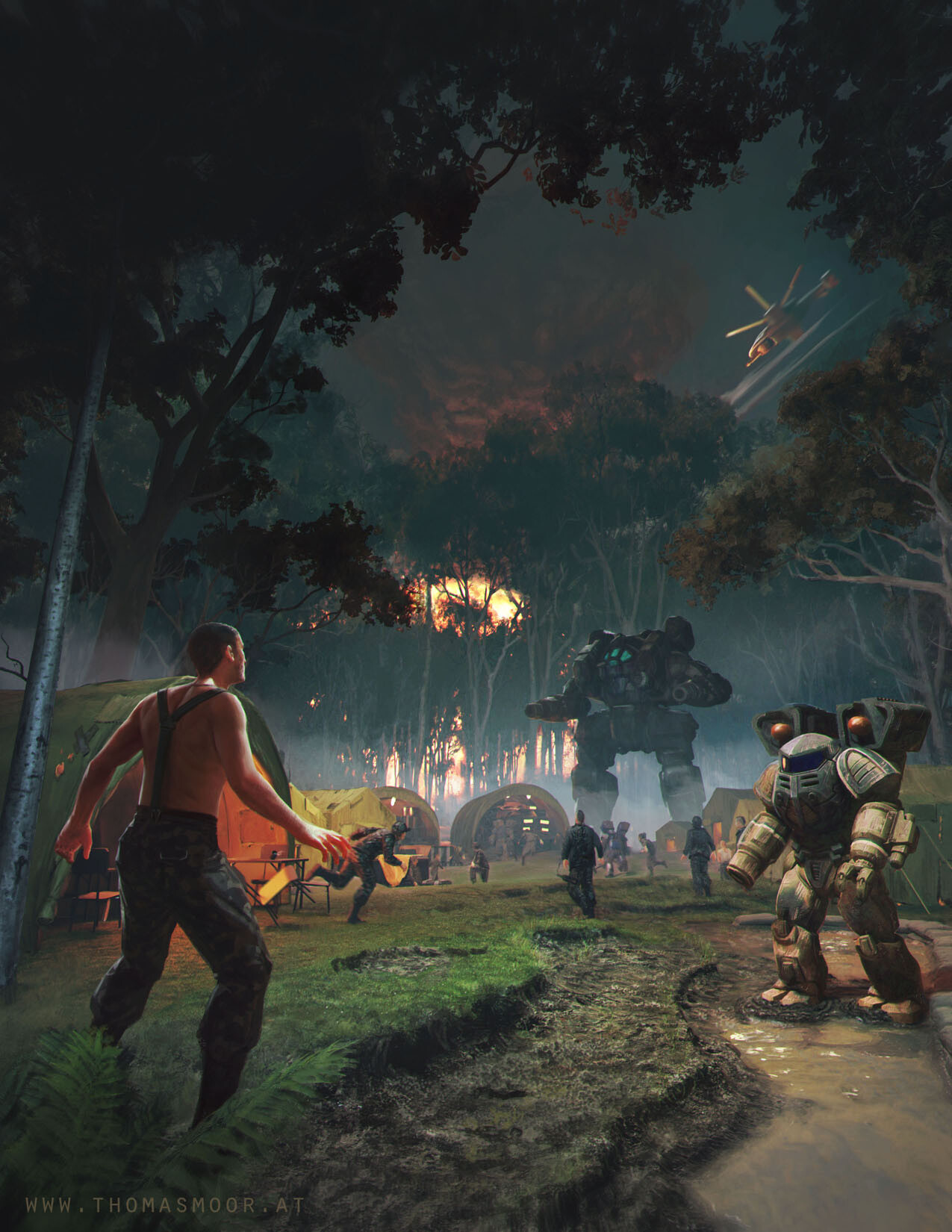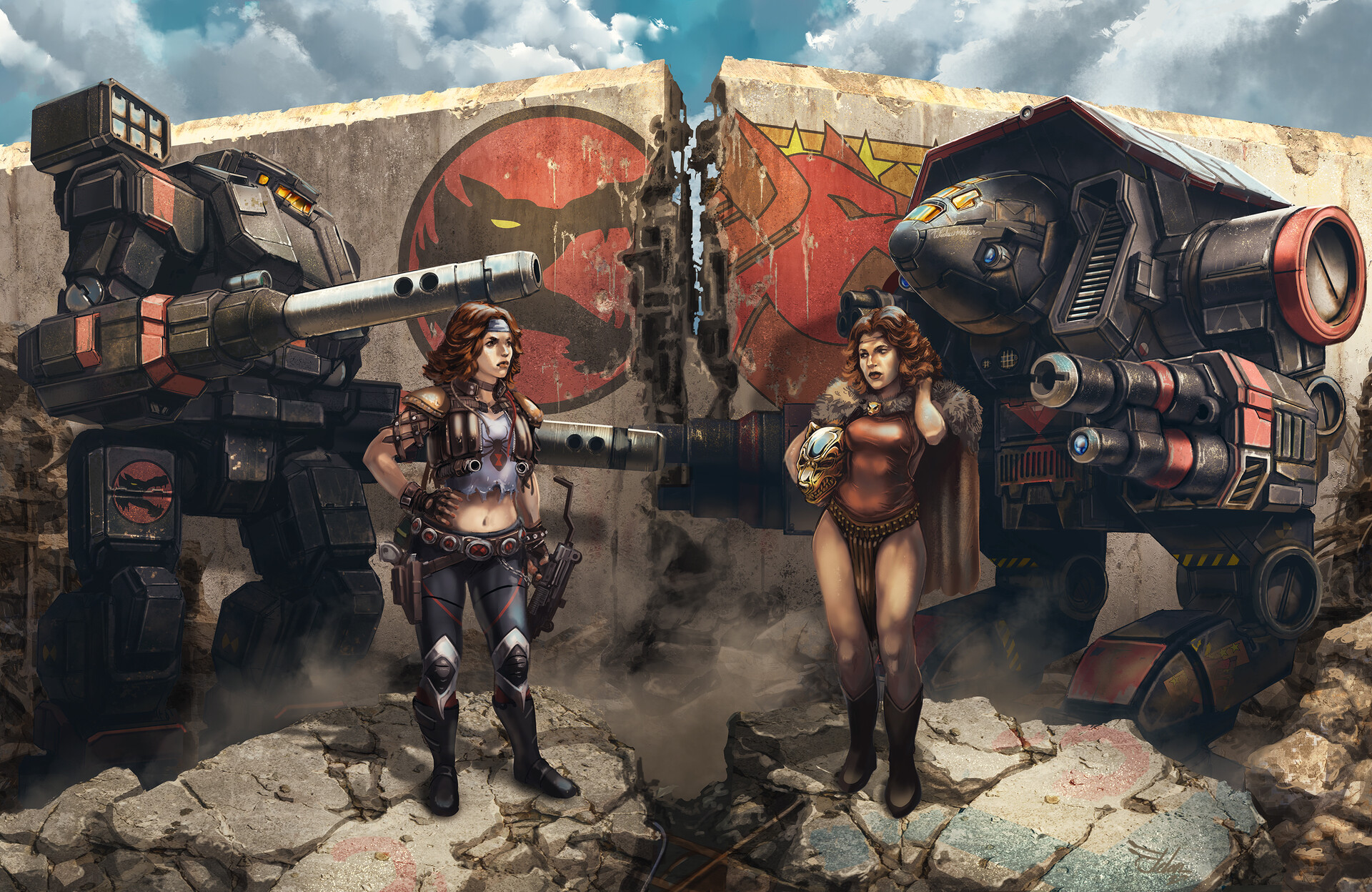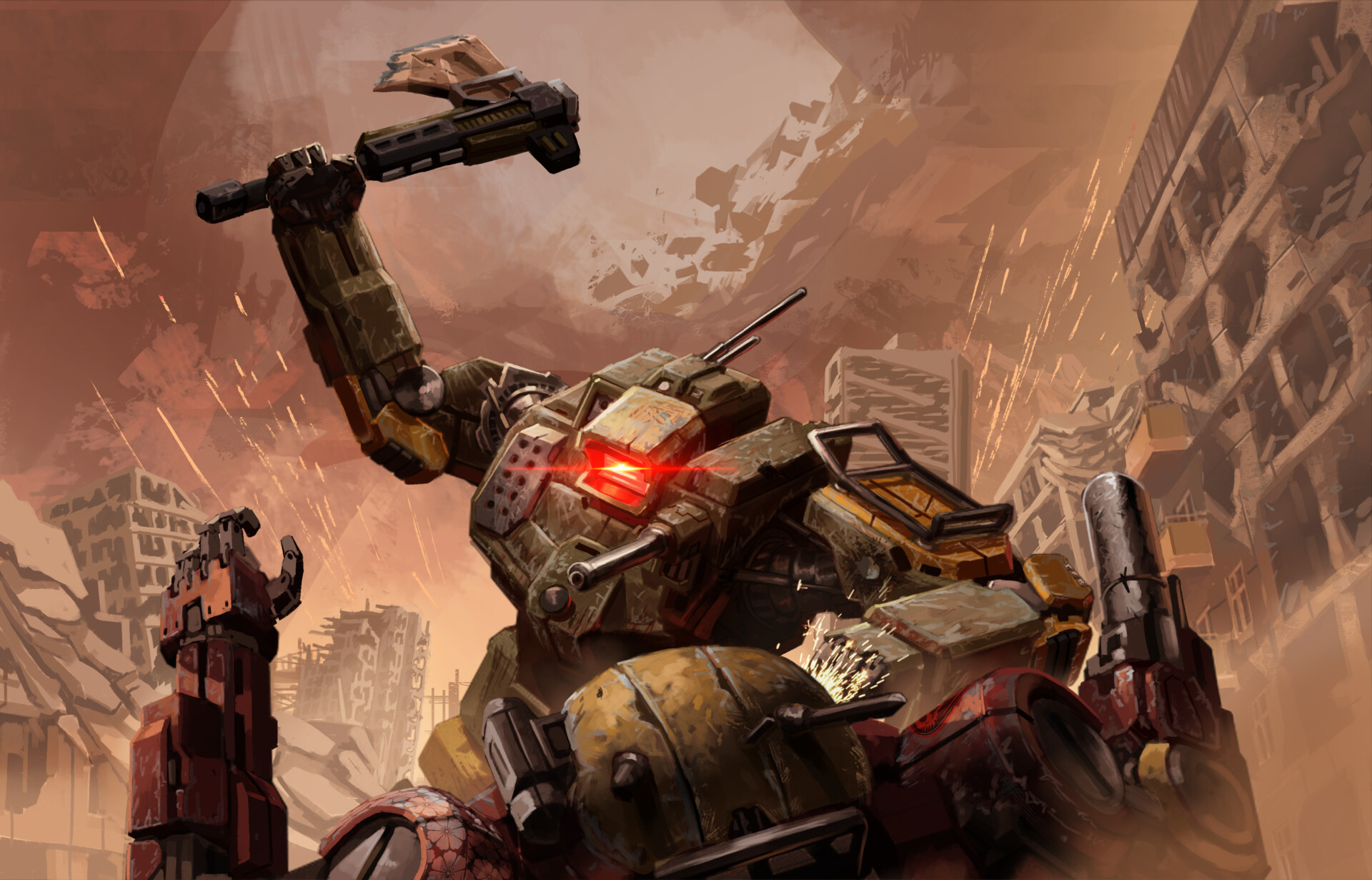Unveiling The Iconic Art Of Battletech: Mechs, Lore & Legacy
Table of Contents
- The Visual Foundation: What Defines Battletech Artwork?
- From Unseen to Iconic: The Evolution of BattleMech Designs
- The Artists Behind the Mechs: Shaping a Universe
- Beyond the 'Mechs: Environments, Characters, and Narrative Art
- The Role of Artwork in Gameplay and Immersion
- Battletech Artwork's Enduring Legacy and Influence
- Collecting and Appreciating Battletech Art
- The Future of Battletech Visuals: New Horizons
The Visual Foundation: What Defines Battletech Artwork?
At its core, Battletech artwork embodies a philosophy of functional brutalism. Unlike some mecha genres that lean towards sleek, almost ethereal designs, BattleMechs are depicted as heavy, industrial war machines. They are not graceful dancers but lumbering titans, designed for punishment and delivering devastating firepower. This aesthetic is deeply intertwined with the game's unique mechanics. When a pilot is considering refitting their 'Mechs, or when a veteran reminds them that "they don’t matter, only" the 'Mech does, it speaks to the machine's central role and its tangible presence on the battlefield. The art emphasizes armor plating, exposed hydraulics, weapon mounts, and the sheer scale of these machines. Every BattleMech is a complex system, and the artwork often highlights this complexity, hinting at the "8 separate lifepools for 8 parts of the mech" or the "paper doll showing the front" that players interact with during gameplay. This isn't just about looking cool; it's about conveying mechanical integrity, vulnerability, and the harsh realities of futuristic combat. The visual style is consistent: gritty, realistic, and often depicting 'Mechs in dynamic poses, amidst the chaos of battle, reflecting the game's premise of pitting 'mech against 'mech on the battlefields of the future.From Unseen to Iconic: The Evolution of BattleMech Designs
The journey of Battletech artwork is as dramatic and storied as the Inner Sphere itself, marked by pivotal shifts that have shaped its visual identity.The Macross Connection and the "Unseen" Era
Perhaps the most famous, or infamous, chapter in Battletech's artistic history revolves around the "Unseen" 'Mechs. For those, like our hypothetical mecha enthusiast, who are familiar with the "drama with Macross," this period is central to understanding the franchise's visual evolution. Early Battletech designs, particularly those featured in the foundational rulebooks and early sourcebooks, drew heavily from Japanese anime series like *Macross*, *Dougram*, and *Crusher Joe*. Iconic 'Mechs such as the Marauder, Warhammer, BattleMaster, and Phoenix Hawk were directly adapted from designs originally created for these shows. This practice, while common in the early days of tabletop gaming, eventually led to significant legal disputes over intellectual property rights. As a result, many of these beloved designs became "Unseen" – meaning they could no longer be officially depicted or used in new Battletech publications. This forced Catalyst Game Labs (and its predecessors) to either cease using these designs or to completely redesign them. The "Unseen" era is a testament to the early artistic influences and the subsequent challenges that shaped the need for a truly unique Battletech visual language.Forging a Unique Identity: The Reseen and Beyond
The challenge of the "Unseen" designs spurred a remarkable period of artistic innovation. Artists were tasked with reimagining these classic 'Mechs, creating "Reseen" versions that captured the spirit and silhouette of the originals while being entirely new and legally distinct. This era solidified Battletech's unique aesthetic, moving away from direct anime influences to a more grounded, heavy-metal sci-fi look. The "Reseen" designs, and indeed all subsequent original Battletech artwork, emphasized the industrial, combat-hardened nature of the 'Mechs. They became more angular, more robust, and distinctly Western in their mecha design philosophy, standing apart from their Japanese counterparts. This evolution wasn't just about legal compliance; it was about the franchise truly finding its own visual voice, a voice that resonated with players and cemented its place as a distinct entity in the mecha genre.The Artists Behind the Mechs: Shaping a Universe
The rich tapestry of Battletech artwork is the product of countless talented individuals who have poured their creativity into bringing the Inner Sphere to life. From the early pioneers to contemporary digital artists, their contributions have been indispensable. The "Data Kalimat" specifically highlights key figures involved in the game's production, giving us insight into the collaborative effort behind the visuals. For instance, Klaus Scherwinski is credited with "cover art," and his work, like many other prolific Battletech artists, often defines the first impression players get of new products. His dynamic compositions and detailed 'Mech renderings capture the intensity of battle and the imposing presence of the machines. Brent Evans is noted for "art direction," a crucial role that ensures visual consistency and guides the overall aesthetic vision across different products and artists. Matt Heerdt, responsible for "cover design," plays a vital role in how the artwork is presented, making it appealing and informative on store shelves. These artists work in tandem with the "Battletech line developer" Herbert A. Beas II and "assistant line developer" Ben H. Rome. While their primary roles are in game development and lore, the line developers are instrumental in shaping the universe's narrative and ensuring that the artwork accurately reflects the established lore and mechanical principles. This collaborative ecosystem, where art direction, design, and development converge, ensures that Battletech artwork is not just pretty pictures, but integral components of a cohesive and immersive universe. Their collective expertise and dedication are what give the franchise its authoritative visual identity.Beyond the 'Mechs: Environments, Characters, and Narrative Art
While BattleMechs are undoubtedly the stars of the show, Battletech artwork encompasses far more than just giant robots. The artists meticulously craft the environments in which these titanic battles unfold, from the war-torn urban landscapes of Terra (like the "Battle of Cairo on Terra" where an Axman takes on the Word of Blake) to desolate alien worlds and the interiors of starships. These backdrops are crucial for establishing the mood and scale of the universe, making the conflict feel real and impactful. Character art also plays a significant role, depicting the grizzled MechWarriors, ambitious nobles, cunning spies, and desperate civilians who populate the Inner Sphere. These illustrations give faces to the factions and provide a human element to the otherwise mechanical warfare. The art often tells a story within itself, capturing moments of heroism, despair, and the brutal consequences of war. For example, the image of "a Stone’s Revenant’s Axman takes the war to the Word of Blake" isn't just a 'Mech; it's a narrative snippet, a glimpse into a specific, epic conflict within the vast Battletech lore. This narrative artwork is essential for deepening the player's connection to the universe, going beyond mere game mechanics to evoke emotion and context.The Role of Artwork in Gameplay and Immersion
Battletech artwork is not just for display; it actively enhances the gameplay experience. The detailed illustrations of 'Mechs, weapons, and components in rulebooks and sourcebooks serve as visual references, helping players understand the intricate mechanics. The "paper doll" diagram, showing the front of a 'Mech with its various hit locations, is a prime example of how art directly aids gameplay, allowing players to track damage and strategize their attacks. This visual feedback is crucial for managing the "8 separate lifepools for 8 parts of the mech" and understanding the tactical implications of each shot. Beyond the practical, the artwork fuels immersion. When players control their several BattleMechs, deciding how each 'Mech moves and when to fire its weapons, the mental image provided by the artwork brings the abstract dice rolls and stat sheets to life. The dynamic poses, the explosions, the sense of scale – all contribute to making each battle feel like an epic confrontation, rather than just a series of numbers. This visual richness is a key reason why Battletech is described as "an epic, ongoing universe with a game simulating" complex warfare. The art bridges the gap between the rules and the imagination, making the experience visceral and memorable.Battletech Artwork's Enduring Legacy and Influence
The distinctive style of Battletech artwork has left an indelible mark on the mecha genre and science fiction as a whole. Its emphasis on heavy, functional designs has influenced countless artists, game developers, and creators. While the franchise has navigated various challenges, including the "Unseen" saga, its visual identity has remained remarkably consistent in its core principles: gritty realism, industrial design, and a focus on the mechanical brutality of war. The ongoing nature of the Battletech universe means its artistic legacy continues to grow. New sourcebooks, video games (like the popular *MechWarrior* series or the *Battletech Extended Commander's Edition* which is a "great next step up from playing vanilla" before moving to "advanced or Roguetech"), and merchandise consistently feature new and classic Battletech artwork, keeping the visual language fresh while honoring its roots. This continuous evolution, guided by experienced art directors and talented artists, ensures that the visual appeal of Battletech remains strong and relevant for new generations of fans.Collecting and Appreciating Battletech Art
For many fans, the appreciation of Battletech artwork extends beyond simply enjoying it within the game. Collecting the art, whether through physical sourcebooks, art books, or even original prints, has become a significant aspect of the fandom. The iconic box art, detailed internal illustrations, and character portraits are often considered masterpieces in their own right. Fans seek out specific pieces that resonate with them, perhaps a depiction of their favorite 'Mech, a pivotal battle scene, or a character they admire. The quality and detail in much of the official Battletech artwork make it highly collectible. Online communities and conventions often feature discussions and showcases of this art, highlighting its importance to the community. This dedication to the visual aspect underscores how deeply embedded Battletech artwork is in the overall experience of the universe.The Future of Battletech Visuals: New Horizons
As Battletech continues to evolve, so too does its visual representation. Modern video games like *MechWarrior 5: Mercenaries* and Harebrained Schemes' *Battletech* (which offers a rich experience for players considering a "next play through before moving onto advanced or Roguetech") push the boundaries of how BattleMechs and their universe are rendered. These digital interpretations bring the classic designs to life with stunning fidelity, leveraging advanced graphics to showcase every detail, from the intricate workings of a 'Mech's joints to the dynamic effects of weapon fire. While technology advances, the core principles of Battletech artwork remain. The commitment to functional design, the sense of weight and power, and the gritty atmosphere continue to define the visual experience. The future of Battletech visuals will likely see a blend of cutting-edge rendering techniques with a deep respect for the established artistic legacy, ensuring that the iconic 'Mechs and their universe remain visually compelling for decades to come.Conclusion
The rich and extensive world of Battletech is brought to life not just by its intricate lore and engaging gameplay, but fundamentally by its powerful and distinctive artwork. From the early, sometimes contentious, "Unseen" designs to the modern, fully realized "Reseen" BattleMechs, the visual identity of the Inner Sphere has been carefully crafted and continuously evolved by dedicated artists and art directors like Klaus Scherwinski and Brent Evans. This Battletech artwork serves not only to illustrate the universe but to immerse players in its brutal, industrial future, making every battle feel epic and every 'Mech a character in its own right. Whether you're exploring the tactical depth of the tabletop game or delving into the lore of the Inner Sphere, take a moment to truly appreciate the visual artistry that underpins it all. It's a testament to the enduring power of good design and consistent vision. What's your favorite piece of Battletech artwork, or which 'Mech design do you find most iconic? Share your thoughts in the comments below, and perhaps explore more articles on the fascinating history of science fiction art on our site!
ArtStation - BATTLETECH ARTWORK

ArtStation - Battletech: Natasha Kerensky fanart

ArtStation - Battletech